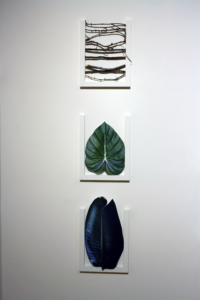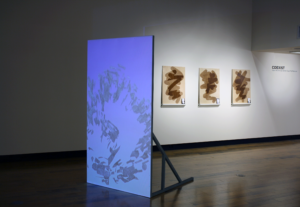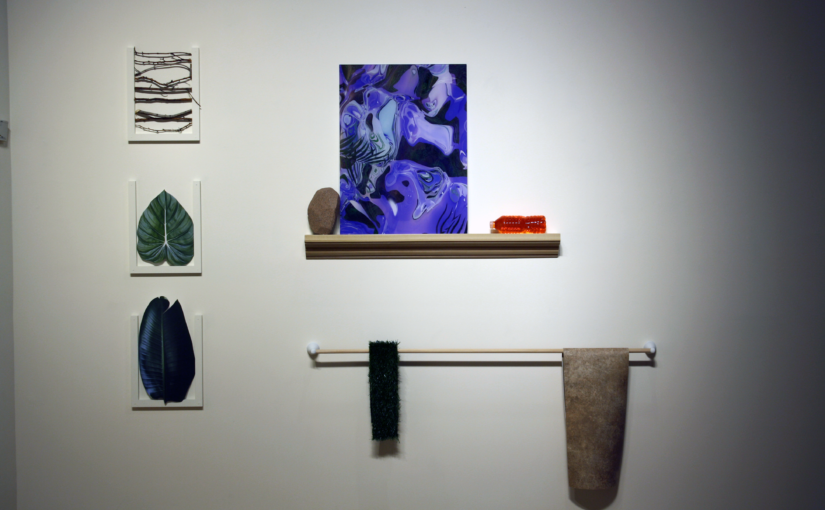
Using digital rendering under Plexiglass, tangible objects and scanned objects, McPherson’s exhibit cohesively starts a discussion about our mimicry of nature in design.
As I look around my apartment, I’m struck by how little is natural. My floors, despite their rugged appearance, are vinyl. The countertop looks like it could be granite, but the fact that it’s bubbling in some places ruins the effect. My door is probably more plastic than it is wood, despite its carefully constructed grain patterns.
In her latest exhibit at the Memorial Union Gallery, artist Sarah Faye McPherson places our mimicry of the natural world into an artistic form. Using sculpture, digital rendering and woodwork, McPherson said she’s trying to build a discussion about what materials we use in our everyday world.
Combining her background in sculpture and digital rendering, McPherson’s works include tangible objects like rocks, leaves and turf, but also feature renderings under Plexiglass and digital deconstructions.
Most of McPherson’s works focus on the topic of how humans mimic nature — a concept that she’s “thinking about all day, every day.”
“That’s where a lot of the work stems from, are this interest in faking the natural world,” McPherson said. “It’s something I don’t think we even realize we’ve started to do. It just kind of filter in. Ever since the ’70s, into architectural elements with that asbestos tile that looked like, you know, rock or whatever. It’s something that’s everywhere now. You can’t go somewhere without seeing something that’s mimicking something else that’s natural. I think it says a lot about us about having control over nature, and how culture has kind of absorbed nature in a way.”

No, those aren’t real leaves: McPherson scanned fake leaves, edited them and printed them off, making them as artistic as the rest of her exhibit.
As an art history major, McPherson notes that this isn’t a new phenomenon. For centuries, humans have been manipulating nature to fit their aesthetics or for certain purposes. Using renderings of Stonehenge and the pyramids, McPherson blows these feats into pieces through a video in her exhibit. Taking them apart reverts them back to their natural forms, free from human involvement.
“The people that created those created them to make these unusual forms that they wouldn’t normally take,” she explained. “It’s such a feat that it’s almost like man versus nature. All of those were huge feats during their time. Like Stonehenge, we were just blown by the technology for that. Same with the pyramids and even for the obelisk, that was something that hadn’t been done before, but it was like a conquering over nature. I’m an art history major as well, so I’m very drawn to those things and what they meant in history for mankind.”
Her exhibit also features three large wood panels with zig-zagging, amorphous shapes. Beside these boards is a corresponding picture of an erased landscape. Gallery director Anthony Faris described this as a dislocation, saying, “You see the natural landscape has sort of been erased and dislocated and recreated on something that is natural and uses the wood grain to frame that space.”
McPherson came upon this idea on accident, however. In the process of adjusting photographs she took in Grand Marais, Minnesota, McPherson said she was “erasing parts of them and being like, ‘Oh, I love that form that they’re taking.'” The erasure marks then became the shapes she stained on to the wood.

McPherson deconstructs historical landmarks in a digitally rendered video (forefront) and wood panels (back) to start a conversation about the erasure of nature.
“I was really thinking about the process of erasing natural objects in the home and erasing almost hiding things or imperfections in natural surfaces,” she explained about the wood pieces. “The staining kind of came as I was thinking about these natural places I’m walking in and how they were shrinking. It seemed like a very obvious connection to erase it in a similar way that you would erase the grains of wood in a furniture piece by staining it.”
With sculpture, woodworking and 3-D rendered images and videos, McPherson’s exhibit doesn’t seem to focus on one medium or even coloring. However, McPherson purposely chose the combination to enhance the conversation she’s trying to elicit in her viewers.
“I wanted to have a combination of (3-D objects) in relationship to the printed works,” she said, “Because I felt like it kind of tied in what I wanted the printed works to say with more of these fake objects. I feel like the printed works by themselves don’t always pull people in that direction of thinking about our control of natural objects, unless you are tying all these other elements into it.”
McPherson’s works will be on display as part of “Coexist” at the Memorial Union Gallery until Sept. 28, with a reception Sept. 19 at 5 p.m. For more examples of McPherson’s works, visit her website at sarahfayemcpherson.com.
